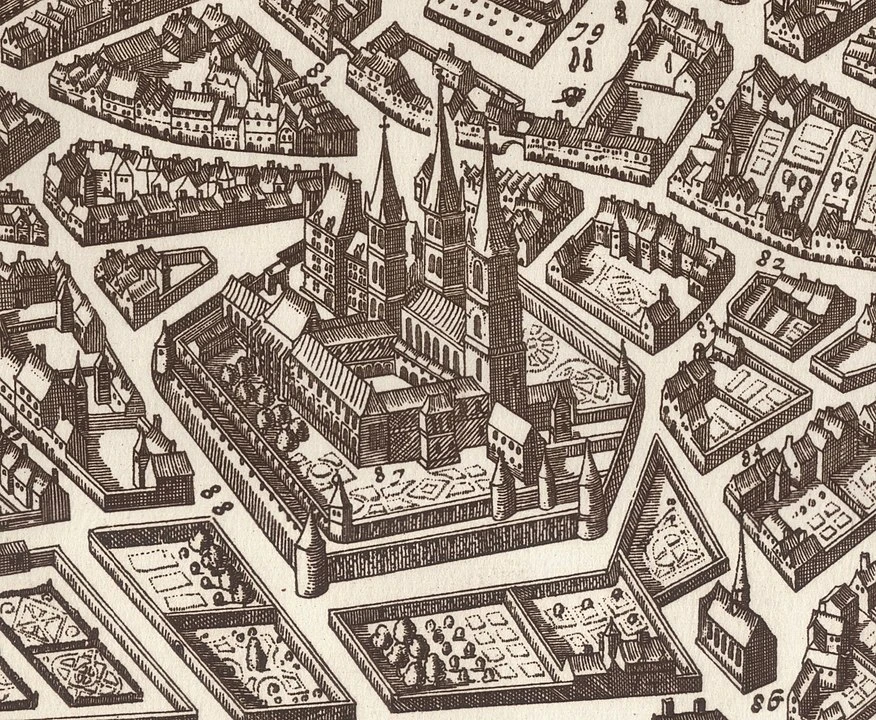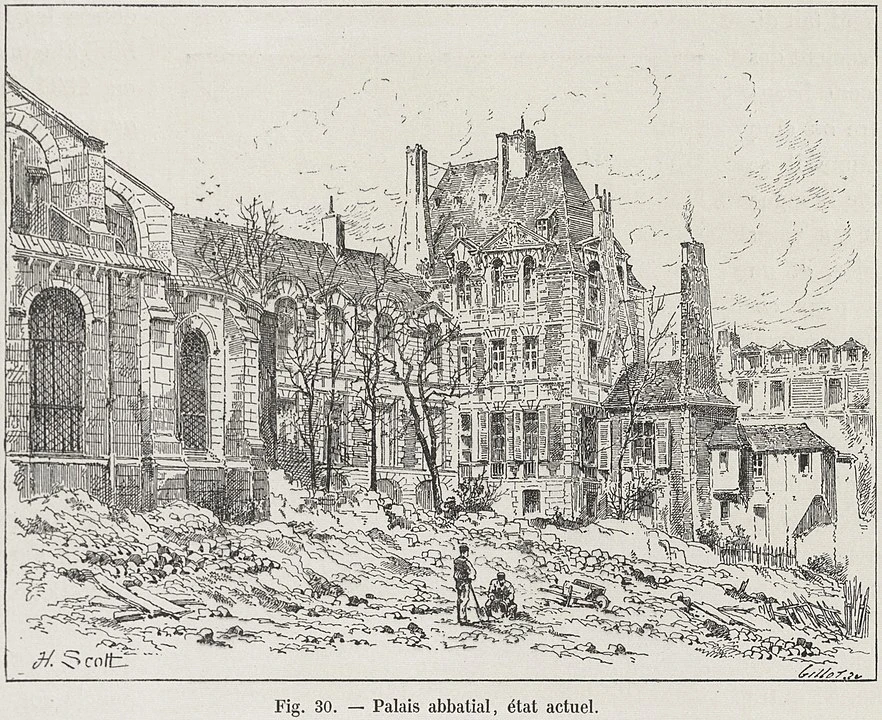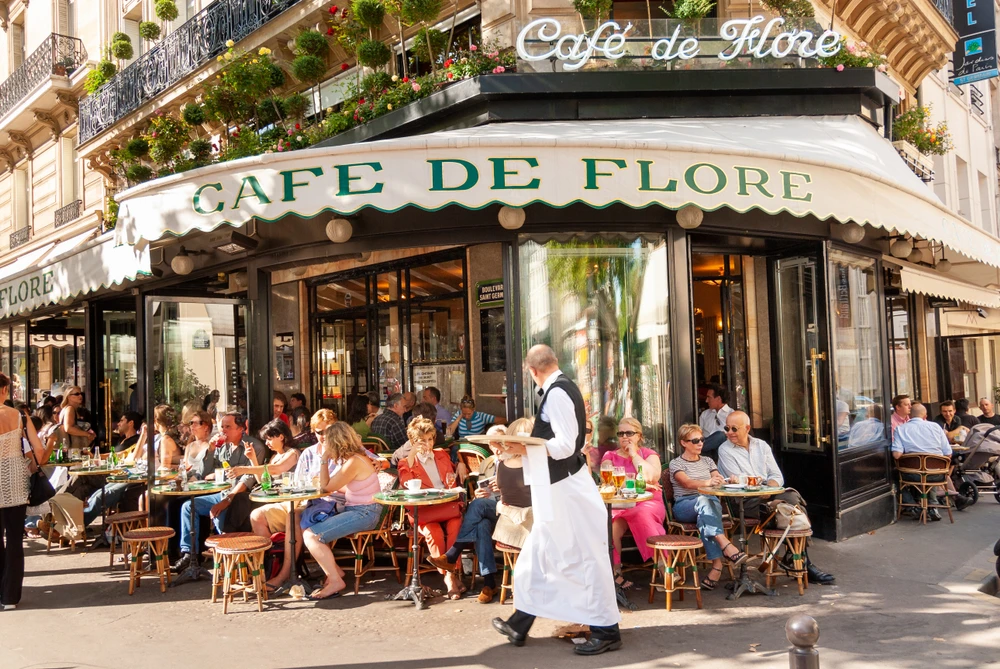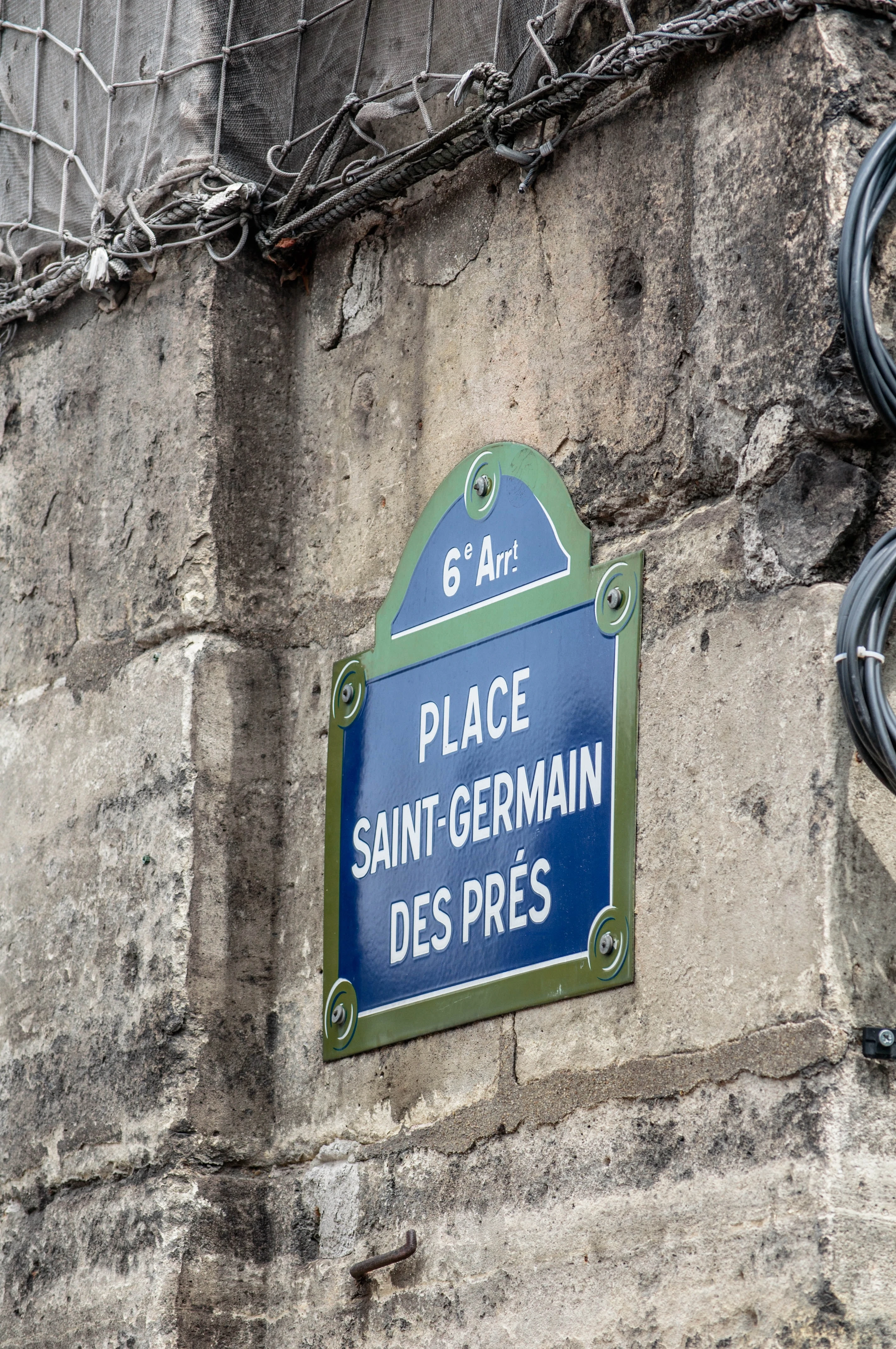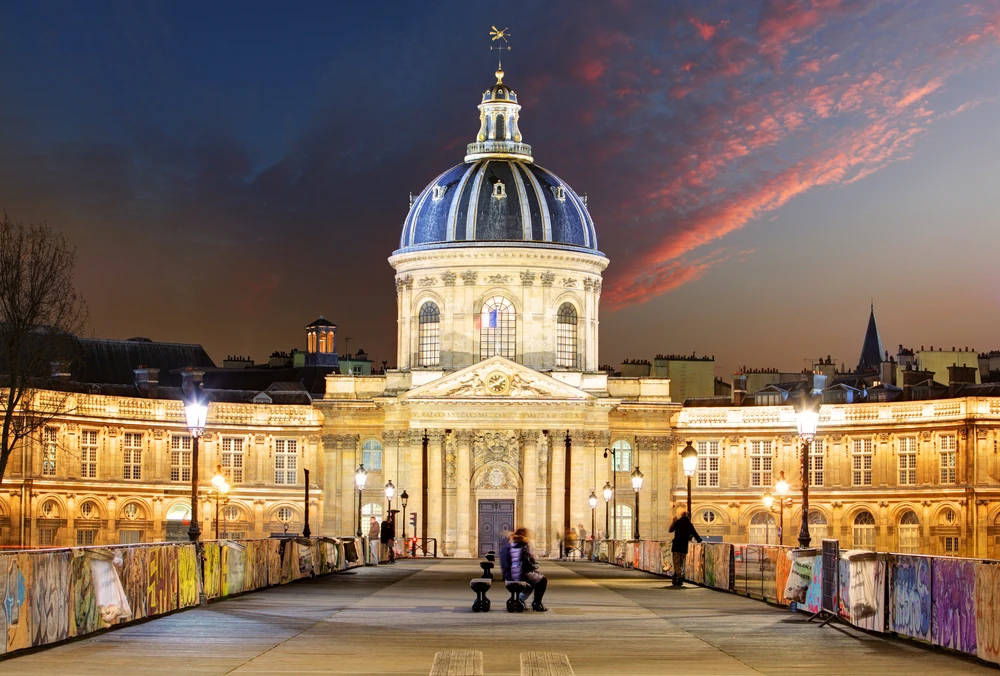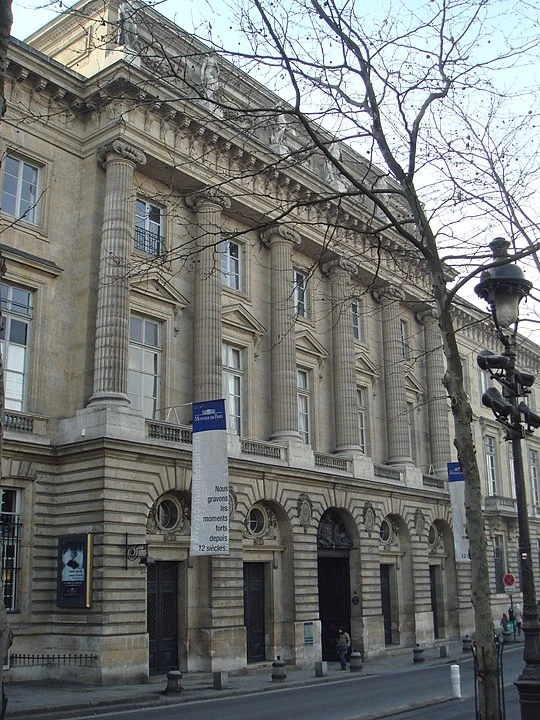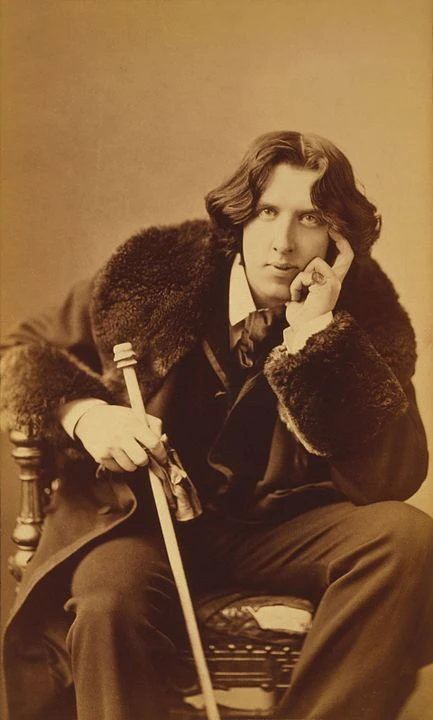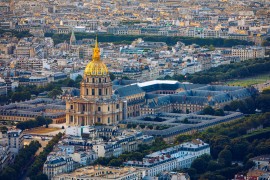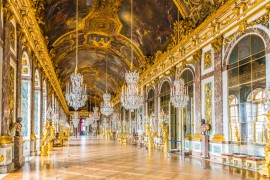The origins: Saint-Germain-des-Prés abbey
Saint Germain des prés in 1618
In the VIᵉ century, Paris was still a small city surrounded by fields and swamps. It was here, in the meadows outside the city walls, that Germain, bishop of Autun, founded an abbey. It was to become one of the capital's great spiritual centers. Saint-Germain-des-Prés soon established itself as a religious and cultural powerhouse. The abbey's immense lands and the activity of its copyist monks preserved and disseminated knowledge. During the Middle Ages, the abbey reached its apogee. Its bell towers dominated the landscape of the left bank, symbolizing the strength of an order that influenced political, spiritual and intellectual life. Pilgrims flocked to the abbey, manuscripts proliferated, and links with the royal power reinforced its prestige. The French Revolution changed all that. The abbey was largely destroyed, its conventual buildings disappeared and its treasures were dispersed. But the main church, now a parish church, survived the turmoil. Even today, the church of Saint-Germain-des-Prés is one of the oldest religious buildings in Paris, blending Carolingian, Romanesque and Gothic elements. It remains the beating heart of the district and the silent witness to over fifteen centuries of history.
👉 To extend the discovery of religious heritage, it's worth also visiting the Notre-Dame de Paris Cathedral and the Sainte-Chapelle.
The dilapidated abbey palace in 1860
Legendary cafés: Flore and Deux Magots
Saint-Germain-des-Prés wouldn't be what it is without its legendary cafés. Le Café de Flore and Les Deux Magots have become literary and philosophical institutions. From the inter-war years and especially after 1945, these terraces became meeting points for the greatest intellectuals. Jean-Paul Sartre and Simone de Beauvoir settled here almost daily. Camus, Queneau, Boris Vian and Juliette Gréco join them. The cafés of Saint-Germain-des-Prés become laboratories of ideas, where philosophies and literary works are constructed. Existentialism, in particular, took shape in the smoke of cigarettes and around the cafés noirs served at Le Flore. Even today, these cafés attract visitors from all over the world. People come to drink a coffee while imagining Sartre writing in a notebook or Beauvoir observing the street. These places embody the living memory of a creative and intellectual Paris.
Café de Flore in Saint Germain des Prés Photo by Alex Segre/Shutterstock
👉 For another dive into the spirit of literary cafés, you should also discover the Quartier Latin, cradle of students and thinkers.
The literary and artistic spirit of Saint-Germain
Saint Germain des prés / Photo by Sophie Louisnard on Unsplash
Already in the XIXᵉ century, romantics strolled through this district. But it was in the XXᵉ century that Saint-Germain-des-Prés truly became the intellectual and artistic center of Paris. Rue de l'Odéon is emblematic. Here, Sylvia Beach founded the Shakespeare and Company bookshop, which published James Joyce's Ulysses in 1922. Across the street, Adrienne Monnier opened the Maison des Amis des Livres, welcoming French writers. This little street became the literary heart of the world. The neighborhood was also home to Juliette Gréco, muse to the existentialists, who sang in jazz cellars like Le Tabou. Jazz from the United States finds an enthusiastic audience here. American musicians, who had settled in Paris after the war, kept the Saint-Germain nights buzzing. Publishing houses like Gallimard, located nearby, reinforce this literary influence. Saint-Germain-des-Prés is both a setting and a source of inspiration for writers, musicians and artists.
Secret streets and squares to discover
To stroll through Saint-Germain-des-Prés is to discover an intimate Paris. Alleys, courtyards and small squares give the district a unique charm. The Place de Furstenberg, with its central tree and lampposts, is one of the prettiest in Paris. It is also home to the Musée Eugène Delacroix, housed in the Romantic painter's former studio. The cour du Commerce-Saint-André, cobbled and lined with old buildings, evokes the French Revolution. Marat's printing works were already located here. Every street in the district retains a memory, every facade seems to have seen history pass by.
👉 For other Parisian strolls, you should also visit Montmartre or the alleyways of Marais.
Monuments and cultural institutions around
The Institut de France Photo by TTstudio/Shutterstock
Saint-Germain-des-Prés is surrounded by prestigious monuments. The Institut de France, with its dome, is home to the Académie française. The Pont des Arts, nicknamed the "lovers' bridge", offers a splendid view of the Seine and the Louvre. The Odéon theater, built in the XVIIIᵉ century, remains one of the high points of French theater. La Monnaie de Paris, an institution founded in the IXᵉ century and still in operation, illustrates the continuity of a unique know-how.
Saint-Germain-des-Prés is at the heart of a Paris where heritage, art and culture meet.
👉 To extend your visit, don't miss the musée du Louvre
The facade of the Monnaie de Paris / By PHGCOM - Own work, CC BY-SA 3.0, https://commons.wikimedia.org/w/index.php?curid=5691175
The atmosphere at Saint-Germain today
In the morning, the bakeries open and the smell of croissants wafts through the alleyways. Cafés raise their metal curtains and the neighborhood slowly awakens. At midday, the terraces fill up. Students, Parisians and tourists mingle. To come to Saint-Germain-des-Prés is to participate in a unique atmosphere, where every table seems to tell a story. In the evening, shop windows light up. Art galleries host vernissages, jazz clubs recall the heyday of Juliette Gréco and Miles Davis. Saint-Germain retains its bohemian, intellectual flavor, which still makes people dream.
👉 To extend your stroll, take a break at the nearby Jardin du Luxembourg, where you can enjoy the peace and quiet of a large green space.
Famous anecdotes and memories
Oscar Wilde / Died in 1900 in Saint Germain des prés (1882 by Napoléon Sarony);
Anecdotes abound at Saint-Germain. It is said that Sartre sometimes wrote directly on the Café de Flore tables. The waiters had to sand the wood to clean them. Juliette Gréco, always dressed in black, sang in jazz cellars and became the icon of a generation. Her name remains associated with the spirit of the neighborhood. Oscar Wilde ended his life here. Every street, every café, every bookshop keeps a trace of those who left their mark on the XXᵉ century. Saint-Germain-des-Prés is an open book that you just have to wander through to turn its pages.
FAQ
What is Saint-Germain-des-Prés?
A neighborhood in the 6ᵉ arrondissement of Paris, born around an abbey in the VIᵉ century and now a cultural and literary mecca.
What to see in Saint-Germain-des-Prés
The abbey church, Café de Flore, Les Deux Magots, Place de Furstenberg and Cour du Commerce-Saint-André.
Why is this district linked to writers and philosophers?
Because in the XXᵉ century, Sartre, Beauvoir, Camus and others lived, wrote and debated here, shaping its identity.
Can we recapture the atmosphere of the 1950s
Yes, cafés, jazz clubs and some bookshops still retain the bohemian, intellectual spirit of the era.
Where Saint-Germain-des-Prés is located
In the 6ᵉ arrondissement, on the left bank of the Seine, a stone's throw from the Latin Quarter and Jardin du Luxembourg.

